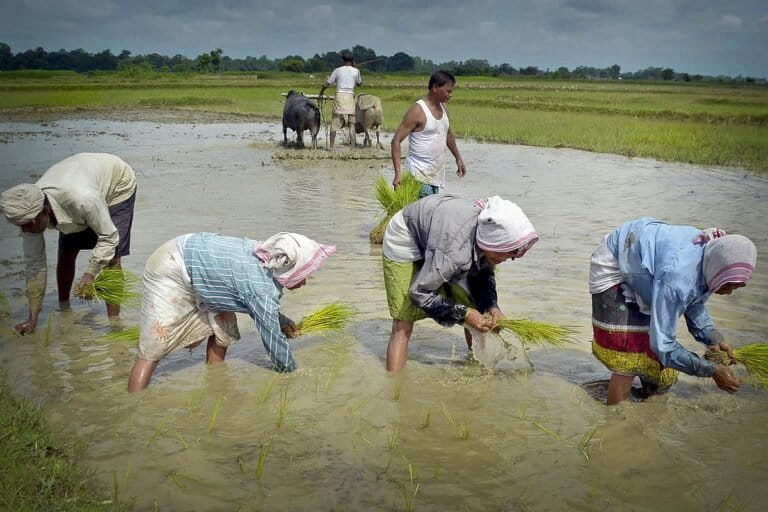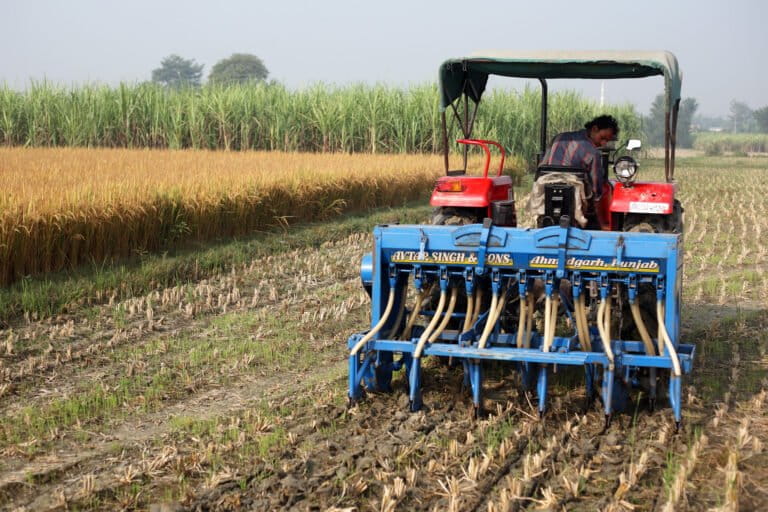- Frequent changes in the weather are affecting agriculture in India.
- The government has recognised the increasing impact of climate change on agriculture. It estimates a loss in production of wheat and rice along with other crops.
- A 2022 study highlights that farmers are recognising changes in weather patterns and independently adapting to its impact on agriculture. Researchers say that targeted policy intervention will make adaptation meaningful.
In late February, the Indian Institute of Wheat and Barley Research (IIWBR), a leading scientific institute for wheat, released an advisory recommending farmers in India to spray potassium chloride on wheat crops in case of a sudden rise in temperature. This was to avoid heat-induced damage caused by temperatures increasing by as much as 10 degrees above normal in some wheat-growing areas of the country. A month later, in the second half of March, IIWBR again released an advisory, but this time it suggested that as light to heavy rains are expected, farmers should keep tabs on the IMD weather update and prevent water logging of the fields. It also advised farmers not to spray chemicals in these climatic conditions.
These advisories, that came close together but with differing recommendations, reflect the weather uncertainties that farmers face and have to adapt to.

Last year, weather uncertainties and extreme weather events saw losses in the agricultural sector. The government, which earned $2121.5 million in 2021-22 from exporting wheat, banned export in May 2022 after the heatwave affected production. That restriction continues. With the expected effect of El Nino, which may cause drought-like situations, India, one of top wheat producing countries, may now need to import wheat.
While talking to Mongabay-India, former Union Agriculture Secretary Siraj Hussain says, “The extent of loss to wheat crops due to untimely rains in March 2023 is yet unknown, but I think the production would still be about 105 million tonnes or more. Since wheat export is banned, India’s wheat balance sheet will not be in trouble. However, climate change is a reality, and our research institutes should be sufficiently funded to breed drought-tolerant crops.”
Government highlights impact of weather uncertainties on agriculture
Recognising climate change’s increasing impact on agriculture, the Union Minister of Agriculture and Farmer Welfare Narendra Tomar, recently shared in the parliament, that the effects of climate change on agriculture in India are expected to reduce wheat and rice production. “In the absence of adoption of adaptation measures, rainfed rice yields in India are projected to reduce by 20% in 2050 and 47% in 2080 scenarios while irrigated rice yields are projected to reduce by 3.5% in 2050 and 5% in 2080 scenarios. Climate change is projected to reduce wheat yield by 19.3% in 2050 and 40% in 2080 scenarios towards the end of the century with significant spatial and temporal variations,” he said, as part of an answer to a Lok Sabha question on March 21. Tomar added that climate change may reduce the kharif maize yields by 18 and 23% in 2050 and 2080 scenarios, respectively.
Previously as well, the union government has highlighted the increase in uncertainty in weather. Some five years ago, in the Economic Survey, the government dedicated one full chapter to climate change and its impact on agriculture.
Based on district-level data, the survey underlined the farm income losses of 15% percent to 18% on average, rising to 20-25% for unirrigated areas. India needs to spread irrigation – and do so against a backdrop of rising water scarcity and depleting groundwater resources, the survey has recommended.
The survey has highlighted the importance of adaptation by saying, “In the absence of any adaptation by farmers and any changes in policy (such as irrigation), farm incomes will be lower by around 12% on an average in the coming years. Unirrigated areas will be the most severely affected, with potential losses of 18% of annual revenue.”

Farmers independently developing climate adaptation methods
While studies and reports emphasise the impact of climate change, farmers are independently observing changes in weather patterns and adapting to these changes, says a study that appeared in August 2022. Farmers have a perception of rise in temperature and erratic and decreased rainfall and their observations are consistent with the meteorological data, the study, by researchers from IIT Kharagpur and Asian Development Bank Institute, concludes.
Analysing empirical studies conducted between 2000 and 2020, the researchers found that more than 57% of farmers perceive a change in precipitation (such as changes in timing and intensity of rain or snow) and 33% find there is a change in temperature (changes in average temperatures and periods of hot or cold seasons). Researchers studied 52 papers, including 35 from online searches and the rest from references.
Based on their observations of the change in the weather patterns, farmers are experimenting with adaptation methods themselves. The researchers have divided these measures into three categories – incremental, systematic, and transformational.
In their study, the researcher found 35 examples of incremental adaptation and 21 examples of each systematic and transformational adaptation. Farmers adopting incremental measures maintain the essence and integrity of current technology, organisation, and administration by changing the elements here and there. It includes changes in sowing and spacing, soil conservation measures, pest and insect management, and water and livestock management. In systematic measures farmers are using new or improved sowing techniques, shifting to climate-ready varieties, improving pest management, etc. Meanwhile, in transformational adaptation, farmers are shifting to a completely new crop system, changing the location of the agriculture field or changing the policy structure.

However, the study also highlighted the limitations of the studies that it has based its analysis on, by saying, “The majority of the studies took ‘farmers’ perception’ too lightly.” These studies just matched farmers’ perceptions with instrumental records.
The reviewed literature does not clarify whether the adaptation actions were explicitly taken in response to the perceived changes in the meteorological variables. It is also unclear how successful these adaptation measures were.
Highlighting the need for more studies, lead author of the paper Pritha Datta says, “Even if we apply all the mitigation measures, the impact of climate change will be visible for several decades. In this case, the role of adaptation becomes important. We should combine local adaptation with national and global mitigation initiatives to deal with climate change impact. For adaptation, we need a targeted initiative like training so that it can become more meaningful.” Pritha Datta is a principal investigator in an Asian Development Bank Institute (ADBI) project.
Datta says, based on their analysis, it is unclear whether farmers are taking adaptative measures because of climate change and it might even be an effort to improve income.
Professor at IIT, Kharagpur, and second author of the paper, Bhagirath Behara says it is clear now that climate change is happening and showing its impact on the ground. Mitigation requires a global effort, but adaptation can be done locally. Farmers are trying to cope with the changing weather pattern on their own. Their adaptation strategies vary from region to region. It shows that there is no one silver bullet. So, engaging with the community is necessary to understand what works better.
He says that the paper highlights the readiness of farmers and a push from policymakers can shape the ongoing adaptation process. Another highlight of the paper is that the knowledge is available at the ground level, and policymakers can use this knowledge to shape the adaptation process.
There are a few other highlights, like a segment of farmers using more fertilisers and pesticides to ensure good production. That is not healthy, noted Behara. If the government runs an awareness campaign or publishes manuals, it will help these farmers to stick to the best practices. Small farmers aware of the good adaptation strategies cannot adopt them because of a lack of credit. These are the areas the government can focus on, Behara said.
Banner image: A paddy field in Kerala. Photo by Anne Roberts/Flickr.
